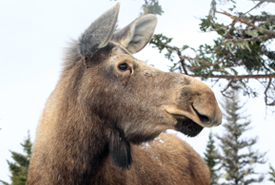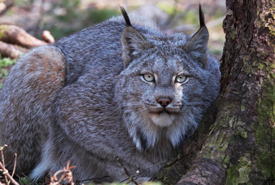Chignecto Isthmus

Endangered Nova Scotia Mainland Moose (Photo by Mike Dembeck)
The Chignecto Isthmus is a narrow strip of land connecting mainland Nova Scotia to New Brunswick and the rest of North America. For centuries, Mi’kmaq First Nations would gather here to meet and to hunt waterfowl, fish, moose, bear and porcupine. The name "Chignecto" derives from the Mi'kmaq word “Siknikt,” which translates to "drainage place" and refers to the great marsh area.
Only 21 kilometres wide at its narrowest, the isthmus separates two large bodies of water: Chignecto Bay, a sub-basin of the Bay of Fundy, and the Northumberland Strait, an arm of the Gulf St. Lawrence, on the Atlantic Ocean. The approximately 50-kilometre-long pinch-point area, located between Moncton and Amherst, is becoming increasingly vulnerable to the severe effects of climate change, and it is one of the most susceptible areas to rising sea levels in all of Canada. The ecological importance of the Chignecto Isthmus is critical to the connectivity of wildlife, plants and humans, including modern-day transportation and commerce. Today, the natural landscape is fragmented by a major highway, rural roadways, a railway line, farming lands and nearby urban areas. The importance of conserving and keeping the remaining natural habitats connected and intact is becoming more important than ever; an ecological balance needs to be maintained for both nature and people to continue to thrive.
Project history
The Nature Conservancy of Canada (NCC) first began our work on the Chignecto Isthmus in 2010 with the first parcel of land being secured on the New Brunswick side. Over the past 12 years, NCC has conserved just over 2,200 hectares through the securement of multiple land donations and purchases on both sides of the border.
NCC continues to steward and expand upon our existing conservation efforts along this critical wildlife corridor. The Town of Amherst, Cumberland County, Province of New Brunswick, Province of Nova Scotia, federal government, other conservation organizations and Indigenous communities are all working to conserve habitat in the region. Other protected areas in the region include the Canaan Bog Protected Natural Area (NB), Chignecto Game Sanctuary (NS), Chignecto Isthmus Wilderness Area (NS), Chignecto National Wildlife Area (NS), John Lusby Marsh National Wildlife Area (NS) and Tintamarre National Wildlife Area (NB).
Conservation values
The Chignecto Isthmus is predominantly covered by Wabanaki (Acadian) forest, though there is little mature or old forest found here. There is also a variety of freshwater wetlands, and coastal saltwater marshes, tidal rivers and mud flats. The area serves as a key wildlife corridor where species can move freely from Nova Scotia through to New Brunswick, eastern North America and the United States, it is critical to their survival. Species such as moose, lynx and bear require large connected natural areas to search out a range of food sources and to ensure genetic diversity and room for population growth. The wildlife corridor is especially important for the movement of moose between New Brunswick and Nova Scotia.
Moose are abundant in New Brunswick while endangered in mainland Nova Scotia. Connected natural habitats on the isthmus allow moose to migrate, find mates and increase the population in Nova Scotia. In addition to moose, there are many other species at risk including Canada warbler, olive-sided flycatcher, rusty blackbird and wood thrush — all of which rely on the forested wetlands. The isthmus also serves as a critical stopover site for migratory shorebirds and waterfowl. The wetland marshes provide nesting areas for American black duck, green-winged teal and wood duck while rivers and creeks are home to wood turtle, eastern wood-pewee and black ash. The grasslands of the historic Acadian dykelands are considered significant habitats for the survival of species like short-eared owl, barn swallow and bobolink.

Endangered Canada lynx (Photo by Mike Dembeck)
NCC is a coordinating member of the Chignecto/Sikniktewaq Partnership, a collaborative group comprised of several environmental organizations, provincial governments and Mi'kmaq First Nations groups. The partners have developed and are nearing the completion of a four-year plan to help conserve species at risk and to encourage broader biodiversity in the Sikniktewaq District of Chignecto. The group’s work in the region includes biological surveys across habitats, monitoring and research on at-risk birds, landowner outreach and education, restoration of forest lands, wetland creation, fencing of streams to protect species at risk habitat, and habitat modeling and assessment for wood turtles. The group’s goal is to evolve into a longer-term vision for the protection of the area and the plants and animals that are dependent on this critical wildlife corridor.
Chignecto/Sikniktewaq Partnership Core Members
- Birds Canada
- Canadian Parks and Wilderness Society NB Chapter
- Community Forests International
- Confederacy of Mainland Mi'kmaq
- Cumberland Wilderness
- Dalhousie University - School for Resource and Environmental Studies
- Ducks Unlimited Canada
- Environment and Climate Change Canada
- Canadian Wildlife Service
- Fort Folly Habitat Recovery
- Government of New Brunswick - Department of Natural Resources & Energy Development
- Government of Nova Scotia - Department of Lands and Forestry
- Government of Nova Scotia - Department of Environment
- Mi'gmawe'l Tplu'taqnn Inc.
- Nature Conservancy of Canada
Environment and Climate Change Canada is the lead funder of the Community-Nominated Priority Places for Species at Risk program.





